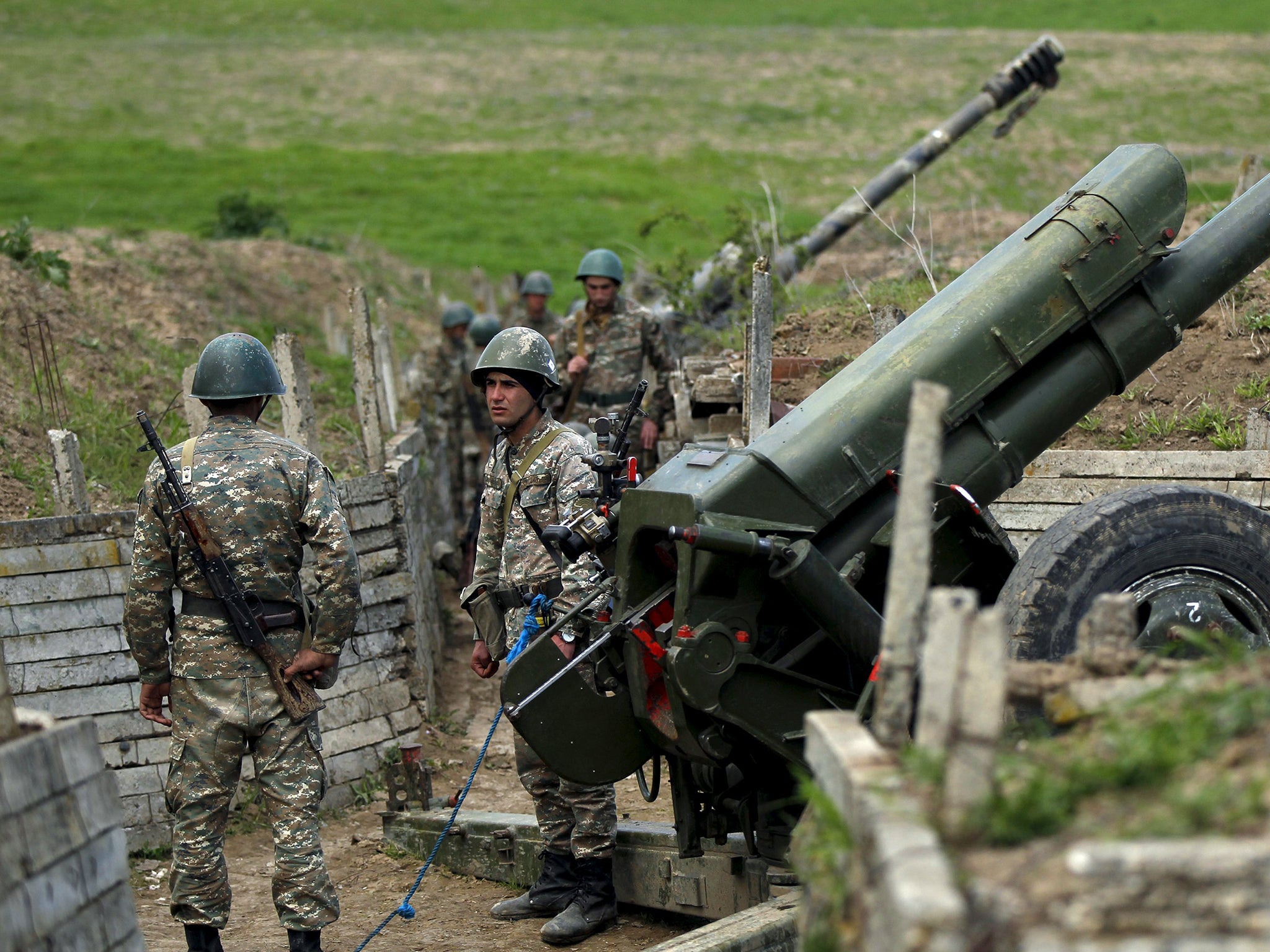Echoes of Stalinism abound in the very modern Azerbaijan-Armenia conflict
The same old enemies are clanking around the black mountains of Karabagh: Russian power, Turkish expansionism and Armenian nationalism


The weariness with which the media reported the latest battle for Nagorno-Karabagh was all too evident during al-Jazeera’s first news reports. Blaming Stalin for the Armenian-Azerbaijan war, the satellite channel showed an old news clip which had absolutely nothing to do with the conflict. The poor quality footage actually showed Winston Churchill presenting to Stalin the Sword of Stalingrad – a gift from King George VI to the Soviet people for their courage in defending the city against Hitler’s Germany and defeating the Nazi Sixth Army in 1943.
Stalin has so often been blamed (as Soviet acting Minister of Nationalities in the 1920s) for giving the mountainous Armenian region to Muslim Azerbaijan – on the grounds that he liked to divide nationalities – that a 20-year discrepancy and the unrelated history of the Second World War didn’t seem to matter. The line from reporters, diplomats and pseudo-experts was pretty much the same when the conflict flared up again this month: here they go again.
Now I have to say that I always thought that the current war in Nagorno-Kharabagh was a particularly dirty conflict. When it was rekindled with the fall of the Soviet Union in 1988, one of Yerevan’s excuses for “taking it back” was that it contained some of the nation’s oldest churches. True. But there are plenty of Turkic historical roots in Karabagh. In much the same way, eastern Europe contains some of Teutonic Germany’s oldest buildings, and much of the Balkans boasts fine Ottoman Turkish architecture. But the ruins of ancient heritage make a very dodgy excuse for war.
By the time I was covering the Karabagh war in the early 1990s, Armenian militia bands were murdering Azeri villagers in massacres eerily similar – though on a smaller scale – to those which occurred during Turkey’s genocide of the Armenian people in 1915; no wonder the Armenians in the capital of Yerevan denied these well-documented modern killings – those at Khojali in 1992, for example – for they undermined the victimhood of the Armenian people.
Yet in Karabagh’s “capital” of Stepanakert, I found little trace of Armenian government troops during the war. What I did see were roving bands of Armenian thugs, some of whom had been involved in the ethnic cleansing of the minority Azeri people. And I fear that for many Armenians in those dramatic days of the Soviet collapse – when Armenian citizens of the Soviet Union were also being slaughtered around Baku – the mountains and old churches of Karabagh became for Armenians a symbol of the equally ancient lands of Ottoman Turkey, from which they were deported in the 20th century’s first industrialised genocide.
The million and a half Armenian dead of 1915 were being avenged in Karabagh – and this is not just mere imagination. I was shocked to discover less than ten years ago that at the great Yerevan shrine to the million and a half martyrs of 1915 – to which Armenians and world leaders flock each April “Genocide Day” – the Armenians have buried the local Karabagh “martyrs” of the 1988-1994 war, men who in some cases may have been war criminals. It was as if the Israelis were to dishonour the Jewish Holocaust memorial at Yad Vashem by burying there the leaders of the Stern Gang of the 1940s.
At the Yerevan shrine stands one of Armenia’s finest research centres into the facts of the 1915 Armenian Holocaust (as The Independent has called it for many years); yet a few hundred metres away are the graves of men who died for Nagorno-Karabagh, a land still recognised by the rest of the world as part of Azerbaijan.
Cynicism only comes to the rescue of hypocrisy when we hear the same old enemies clanking around the black mountains of Karabagh: Russian power, Turkish expansionism and Armenian nationalism. Given his current policies – or medical condition – it’s unclear whether Turkish President Recep Tayyip Erdogan models himself on Mustafa Kemal Ataturk or the last mad rulers of post-First World War Pan-Turkism. In this weird scenario, does Vladimir Putin represent the Tsar who allied himself to the Armenians in the First World War – or the Bolsheviks who were happy to divide Azeris from Armenians?
In one sense, Putin is playing Putin the “intervener”. He is, after all, the intervener of Georgia and the intervener of Ukraine and the intervener of Syria. And now he is the intervener of Karabagh, or Azerbaijan.
Join our commenting forum
Join thought-provoking conversations, follow other Independent readers and see their replies
Comments
Bookmark popover
Removed from bookmarks